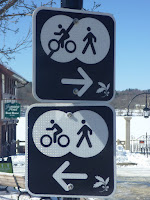 |
Going with the wind: “Ploughed Hill wane” in Seven Hills Park
|
We learn at school that Rome was founded on seven hills. There are many other cities following such a claim. Somerville in Massachusetts is one of them. Living in a “Seven Hills City” seems to invoke the feeling of magical splendor. Here, we “hop the hills” by following the Seven Hills Park installations to get some snapshots of the history of the city of Somerville, which began as an early New England settlement.
Today's densely populated Somerville is located next to Cambridge to the northwest of Boston. Somerville is stretched out over a series of drumlins between Boston's Charlestown and Arlington. These glaciation-built ridges south of the Mystic River became known as the Seven Hills. They are:
- Central Hill
- Winter Hill
- Spring Hill
- Clarendon Hill
- Cobble Hill
- Ploughed Hill
- Prospect Hill
Walking through Somerville today, it is difficult to recognize these hills or drumlins as distinct geographic features. Construction and earth movement have changed the original Somerville landscape. The hills are part of the interesting history of Somerville. Highlights, as well as stressful episodes, of their past are emphasized in Seven Hills Park—a tiny park just west of the Davis Square MBTA Station serving the Red Line.
You need to look upwards to see the wind-activated objects that depict the “hill stories.” Hovering over tree branches and backdropped by the blue sky (or clouds), you will find them installed at the tip of brick-and-steel towers. The associated stories are found on plaques at the red-brick base. Central Hill is presented by the Seven Hills Park clock (see right-side picture). The other hills are featured in the following, including the plaque text and a few scattered comments.
Winter Hill
 |
An orchard tree as a symbol for the early 19th century farming landscape of Winter Hill
|
The site of a Revolutionary War fort, Winter Hill also supported orchards and farms until the early 19th century. In the 1840s, much of the hill was subdivided for residential housing, and lost was the extensive apple orchard of John Poor. The remaining apple trees shaded the yards of some of the homes for many years.
Spring Hill
 |
Dairy cow weather wane
|
As part of the “Stinted Commons” Spring Hill provided excellent farm sites for Charlestown residents in the 18th and early 19th century. Farming, particularly the raising of dairy cows, was prevalent until the Civil War. The aptly named “Milk Row” (now Somerville Ave) provided a route to bring dairy products to Boston.
Clarendon Hill
 |
| Fished at the bottom of Clarendon Hill: Alewife |
In the 18th century, Clarendon Hill's land use was agricultural and remained so until the mid-19th century. Fishing for Alewives in the stream at the bottom of the hill (now known as Alewife Brook) was an occupation of some early residents. The fish were salted and shipped to the West Indies in exchange for molasses which as brought to nearby rum distilleries.
The Red Line MBTA terminal west of Davis Square is named Alewife. Such, this herring species got literally on the map—the Boston transit map.
Cobble Hill
 |
Miniature of the now razed Joseph Barrell House
|
The Joseph Barrell House, designed by Charles Bulfinch, was located on Cobble Hill, site of a Revolutionary War fort. In 1816 the house and land were purchased to establish McLean Asylum, which was moved to Belmont, MA in 1896. The Barrell House was razed and Cobble Hill was slowly carved away for landfill.
Ploughed Hill
In the 17th and 18th centuries Ploughed Hill was used primarily as grazing land. It also served as a fort during the Revolutionary War. The Ursulines of the Mount Benedict community chose the site for a convent, teaching young Catholic and Protestant women. The convent was burned by an angry anti-Catholic mob in 1834. The hill was later carved away for landfill.
The associated object is shown in the picture at the top of this post. I am not sure if this is a replica of the convent. It is typically referred to as a schoolhouse.
Prospect Hill
 |
Prospect Hill Tower in the sky
|
Prospect Hill is Somerville's most historic hill. A fort was built on this site during the American Revolution. The first flag of the colonies was flown here in January 1776. By 1882 much of the hill was carved away to fill the Miller's River. In the early 20th century the granite tower and park were built to commemorate the significance of the the hill in the Revolutionary War.
The real landmark granite structure of this miniature “towers above” Somerville's Union Square. It became known as the Prospect Hill Tower or Prospect Hill Monument.
Note: On the Prospect Hill plaque, rusty brown spots are obscuring parts the yellow-on-blue printed text. I tried my best to fill in missing words to the best of my pattern recognition abilities and also used search results. My intention was to stay within the given text flow and not to manipulate story or facts as presented on the plaque. All installed objects show some rusty spots or weather-related erosion. This actually adds to their charming appearance and historical setting.
The Seven Hills Park installations have been pinned to my board Magnificient Massachusetts.
References and further reading
Seven Hills Park. Bouseblog - Local History from Somerville, Mass. 6/5/2015. https://bouseblog.wordpress.com/2015/06/05/seven-hills-park/. (accessed 3/14/2021).
Seven Hills. Post No. 51. 8/11/2010. Website: https://summerinsomerville.wordpress.com/tag/seven-hills/ (accessed 3/14/2021)
Madeline Bilis. Landmark: Somerville's Prospect Hill Tower. Boston magazine, 2/21/2017. Website: https://www.bostonmagazine.com/property/2017/02/21/somerville-prospect-hill-tower/ (accessed 3/14/201).





















